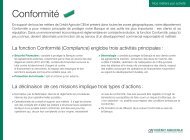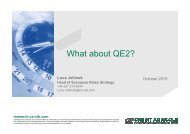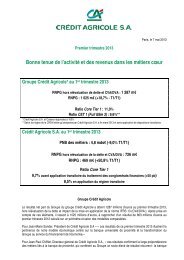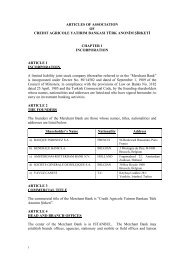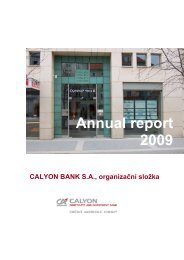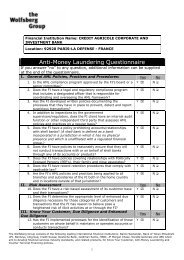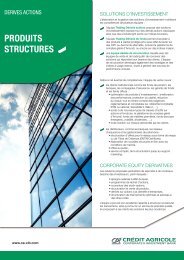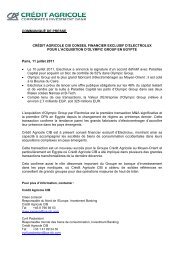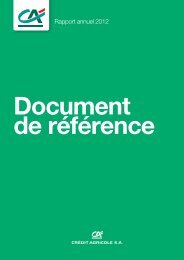ourexpertise - Crédit Agricole CIB
ourexpertise - Crédit Agricole CIB
ourexpertise - Crédit Agricole CIB
Create successful ePaper yourself
Turn your PDF publications into a flip-book with our unique Google optimized e-Paper software.
CORPORATE GOVERNANCE 2Second-degree, first-level controlsAs well as having responsibility for the administrative processingof all transactions, back offi ces perform checks on the activitiesof the front offi ces during the recording and execution of transactions,namely by comparing data in front-offi ce databases withback-offi ce data and information provided by the counterparties.These controls are coordinated locally by the entity’s head, via theChief Operating Offi cer or the offi cer responsible for administrationor fi nance.Second-degree, second-levelcontrolsThese controls are carried out centrally by specialised units:• Role and responsibilities relating to therisk managementRole and responsibilities relating to the riskmanagementThe Risk Management and Permanent Controls Division (RPC) isresponsible for supervising risks within <strong>Crédit</strong> <strong>Agricole</strong> <strong>CIB</strong>.The purpose of this division is to control credit risks, country risks,market risks, and operational and accounting risks. However,structural fi nancial risks are managed by the fi nance department.To control these risks, it oversees the Group’s commercial developmentin order to minimise risk-related costs relating to the activitiesof the different business lines, entities or units.The RPC is also in charge of monitoring the risk management andpermanent control system, defi ned above, for the whole of <strong>Crédit</strong><strong>Agricole</strong> <strong>CIB</strong>.The risk management and permanent controls organisation within<strong>Crédit</strong> <strong>Agricole</strong> <strong>CIB</strong> forms part of the risk management andpermanent controls function set up within the <strong>Crédit</strong> <strong>Agricole</strong> S.A.Group.<strong>Crédit</strong> <strong>Agricole</strong> <strong>CIB</strong> holds certain powers in managing its risks.Any cases outside the scope of its powers, as well as certainsignifi cant risk strategies, are validated by the « Group Risk ManagementCommittee«.<strong>Crédit</strong> <strong>Agricole</strong> <strong>CIB</strong> Head of Risk management and permanentcontrolss reports hierarchically to the <strong>Crédit</strong> <strong>Agricole</strong> S.A. Headof Group Risk Management and Permanent Controlss and functionallyto <strong>Crédit</strong> <strong>Agricole</strong> <strong>CIB</strong> Executive Management. It is partof the bank’s executive committee (Comex). The Head of RiskManagement and Permanent Controlss is responsible for therisks sector and permanent controls within the meaning of CRBFregulation 97-02 as amended.Within <strong>Crédit</strong> <strong>Agricole</strong> <strong>CIB</strong>, RPC is organised as an independentglobal business line. It combines all head offi ce risk functions andactivities, as well as local and regional offi cers in the internationalnetwork. At 31 December 2010, RPC had a worldwide staff of999 (full-time equivalents).<strong>Crédit</strong> <strong>Agricole</strong> <strong>CIB</strong> has implemented a set of procedures thatdetermines risk monitoring, risk control and permanent controlarrangements. The set of procedures is updated regularly to improverisk measurement and supervision.Governance<strong>Crédit</strong> <strong>Agricole</strong> <strong>CIB</strong> governance bodies (Audit Committee andBoard of Directors) receive a report on Risk Management andmain exposures quarterly, a report on Risk situation semi-annuallyand specifi c monographs when needed.Risk management is structured around the two following bodies:• a Strategic Risk Management Committee (CSR), which enhancesrisk supervision and supplements the governance system,• a Strategy and Portfolio Committee (CSP), which oversees eachlocation/country, each signifi cant subsidiary within a specifi cstrategyDecision-making process is based on selected cases by dedicatedcommittees:• Business and geographical Committees are in charge of retailfi nancing within the limit granted to each manager;• the most signifi cant fi les are reviewed by the Counterparty RiskCommittee (CRC)• the Market Risk Committee (CRM) monitors market exposurestwice a month.In addition to the Committees in charge of risks (CSR, CSP, CRC,CRM), risk management is also presented to the following ExecutiveManagement bodies:• <strong>Crédit</strong> <strong>Agricole</strong> <strong>CIB</strong> Executive Committee (Comex)• Internal Control Committee• Faîtier Central Permanent Control Committee which validatesthe work assigned to permanent controls and reviews the permanentcontrol systems of the business lines, subsidiaries orbranches and cross-functional issues.<strong>Crédit</strong> <strong>Agricole</strong> <strong>CIB</strong> is part of the <strong>Crédit</strong> <strong>Agricole</strong> S.A. risk mangementprocess which is structured by the following bodies:• The Group Risk Management Committee (CRG). <strong>Crédit</strong> <strong>Agricole</strong><strong>CIB</strong> mainly presents to the committee its approvals, its mainlimit risk strategies, its budgets by country, the corporate significant outstanding, the sensitive cases as well as the marketrisk situation;• The Supervisory Risk Management Committee which reviewscounterparties which present signs of deterioration or a need ofarbitrage between entities of the Group;• The Standards and Methodology Committee (CNM) to which<strong>Crédit</strong> <strong>Agricole</strong> <strong>CIB</strong> submits for decision any proposal of methodologyas regards to qualifi cation under the Basel Committeebefore implementation in <strong>Crédit</strong> <strong>Agricole</strong> <strong>CIB</strong>;• The <strong>CIB</strong> Business Line Monitoring Committee which reviews<strong>Crédit</strong> <strong>Agricole</strong> <strong>CIB</strong> risk situation as well as the progress ofsome of these processes.Risk master planThe risk master plan was launched in late 2007 to address theneed to adopt a view of the medium- to long-term trends inrisk management. The aim is to accelerate improvements andto ensure consistency among the main areas for improvement,enabling <strong>Crédit</strong> <strong>Agricole</strong> <strong>CIB</strong> to assess its risks more quickly andwith greater precision while taking into account the strategicdecisions of <strong>Crédit</strong> <strong>Agricole</strong> <strong>CIB</strong>’s Refocusing and Developmentplan.It covers three broad areas: organisational aspects that needto be adjusted, processes that need to be streamlined and ITsystems that need to be speeded up or introduced. It deals withthe major types of risks: counterparty risk (including on capitalmarkets transactions), market risks and operational risks. Itcovers related projects whose risk-management aspects aredependent on the plan.SHELF-REGISTRATION DOCUMENT CRÉDIT AGRICOLE <strong>CIB</strong> 2010 49



